Post-Operative Care Information For Hips
The following are some ways to incorporate movement after you have had hip replacement surgery. Discuss these techniques with your physicians and orthopedist before attempting them. Your physical therapist may modify some of these techniques depending upon your situation (i.e., age, weight, and procedure). Only do the techniques that are recommended by your physician and/or therapist.
Getting Out of Bed
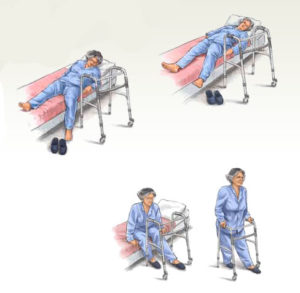 Step 1 – Get out of the bed on the same side as your operated leg. Your physician and/or physical therapist will show you how to move your operated leg properly and will assist you the first few times while you’re in the hospital.
Step 1 – Get out of the bed on the same side as your operated leg. Your physician and/or physical therapist will show you how to move your operated leg properly and will assist you the first few times while you’re in the hospital.
Step 2 – Pivot on your hips using your elbows to help. Keep your body straight with your operated leg kept to the side. Do not twist your leg.
Step 3 – Move your unoperated leg around and sit on the edge of the bed keeping your operated leg straight. Hold onto your walker for support and stand. Do not bend forward as you try to stand.
Sitting
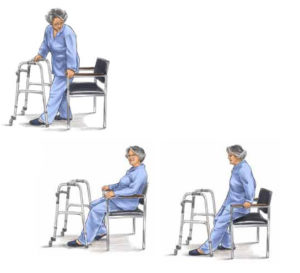 Step 1 – Sit in firm, straight-backed chair with high seats and armrests. You should avoid low, overstuffed chairs. Back your walker up until you feel the chair touching the back of your legs.
Step 1 – Sit in firm, straight-backed chair with high seats and armrests. You should avoid low, overstuffed chairs. Back your walker up until you feel the chair touching the back of your legs.
Step 2 – Release your hands from the walker and reach down and hold onto the armrests. Slowly lower yourself keeping your operated leg straight out in front.
Step 3 – Sit then slide back in the chair bending your unoperated leg first. You use this technique when using a toilet with arm rails as well.
Walking
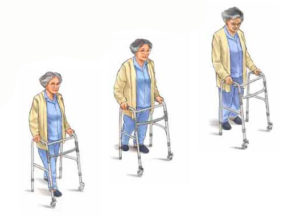 Once you can stand, you will use a walker to help you keep your balance. Initially, you will be told to place only a small amount of weight on your operated leg as you walk. As you become stronger, your doctor will tell you when you can increase the amount of weight placed on your operated leg.
Once you can stand, you will use a walker to help you keep your balance. Initially, you will be told to place only a small amount of weight on your operated leg as you walk. As you become stronger, your doctor will tell you when you can increase the amount of weight placed on your operated leg.
Step 1 – Place the walker a few inches in front of you and hold on to the walker firmly with both hands. Keep your hip straight and step your unoperated leg into the center of the walker. To protect your hip, avoid rotating your hip or foot.
Step 2 – Lean on the walker and let it support your weight. Step forward and through the walker with your operated leg. Be careful not to wrap your leg around the legs of the walker.
Step 3 – Lift your walker straight up (if it doesn’t have wheels). Be sure to place all four of its legs down before stepping forward again.
Crutches
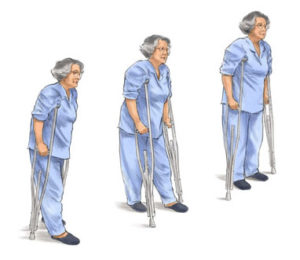 Once your muscles are strong enough, your physical therapist and/or physician may recommend crutches instead of using a walker. Your therapist will give you guidelines on how far and how long you may walk. When using crutches, put your weight on your palms, not your armpits. Don’t twist to turn, take small steps instead. Your physician and/or therapist will tell you how much weight you can put on your operated leg.
Once your muscles are strong enough, your physical therapist and/or physician may recommend crutches instead of using a walker. Your therapist will give you guidelines on how far and how long you may walk. When using crutches, put your weight on your palms, not your armpits. Don’t twist to turn, take small steps instead. Your physician and/or therapist will tell you how much weight you can put on your operated leg.
Step 1 – With the crutches firmly in place, place pressure on your hands, not on your armpits.
Step 2 – Move the operated leg and both crutches forward at the same time.
Step 3 – Looking up and straight ahead, first step through the crutches with the operated leg followed by your unoperated leg.
Walking Up Stairs with Crutches
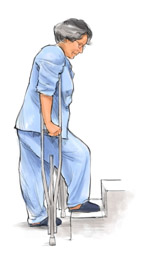 With your crutches upright on the floor and firmly planted for support, lift your unoperated leg and place it on the step. Leaning forward on the crutches, lift yourself up. Use the crutches and your unoperated leg to support your weight. Now lift your operated leg up onto the step. You may want to have someone help you the first few times until you become comfortable with stairs.
With your crutches upright on the floor and firmly planted for support, lift your unoperated leg and place it on the step. Leaning forward on the crutches, lift yourself up. Use the crutches and your unoperated leg to support your weight. Now lift your operated leg up onto the step. You may want to have someone help you the first few times until you become comfortable with stairs.
Walking Down Stairs with Crutches
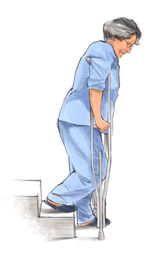 Place your crutches and your operated leg on the lower step. Use the crutches for balance and lower yourself carefully down onto the step moving the crutches as you move the operated leg. Again, you may wish to have someone assist you the first few times you try this.
Place your crutches and your operated leg on the lower step. Use the crutches for balance and lower yourself carefully down onto the step moving the crutches as you move the operated leg. Again, you may wish to have someone assist you the first few times you try this.
Avoid Risky Movements
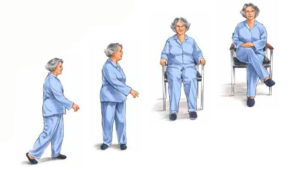 At first, some movements will put too much strain on your new hip joint, which could cause the ball to slip from its socket. A therapist will teach you which movements to avoid. A few of the riskiest ones are:
At first, some movements will put too much strain on your new hip joint, which could cause the ball to slip from its socket. A therapist will teach you which movements to avoid. A few of the riskiest ones are:
Sitting
Don’t let your knee cross the midline of your body.
Rather, sit with both feet on the floor, with your knees six inches apart.
Turning
Don’t plant your foot and rotate your new hip inward.
Rather, turn both your feet and your body.
Bending Down
Don’t bend all the way over from the waist.
Rather, use a device, such as a long-handled grabber to reach down.
Once You Are At Home
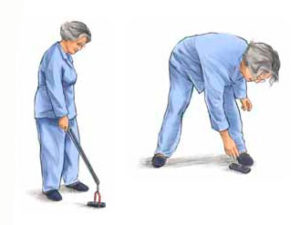 It is very important that you follow your surgeon’s instructions. The following suggestions should be discussed with your surgeon before your hospital discharge:
It is very important that you follow your surgeon’s instructions. The following suggestions should be discussed with your surgeon before your hospital discharge:
- If you will be using a walker or crutches to assist with walking, ask your doctor how much weight you may put on your operated leg. Remember that you will probably tire more easily than usual. You may want to plan a rest period of 30 to 60 minutes mid-morning and mid-afternoon.
- It is safer and easier to get in and out of chairs using both arms and you should avoid low or overstuffed furniture. To increase your comfort, use a cushion or pillow to raise your body while seated.
- An elevated toilet seat may reduce stress to your hips and knees as you sit and stand.
- A shelf placed in the shower at chest height may reduce having to bend to retrieve items while in the shower.
- A bathtub seat (bench) allows you to sit while bathing for increased safety and comfort.
- A long-handled bath sponge may be used to reach lower legs. Women can also purchase razor extenders to shave their legs.
- Avoid sweeping, mopping, and running the vacuum cleaner. Use long-handled feather dusters for dusting high and low items. Your doctor will tell you when it is okay to sweep, mop, and vacuum.
- You may ride in a car, but you must follow your doctor’s instructions for how to get in and out of the vehicle. You can raise the height of the car seat with pillows to protect your hips and knees as well.
- Your doctor will talk with you about when you can drive, typically within four to six weeks after surgery. If you have a car with a manual transmission, talk with your doctor about driving limitations. Make sure you can brake the car without discomfort before you attempt to drive in traffic.
- Constipation is a common problem for patients following surgery. This is usually due to your limited activity and any pain medications you may be taking. Discuss your diet with your doctor. It should include fresh fruits and vegetables as well as eight full glasses of liquid each day unless your doctor tells you otherwise.
- Your doctor will probably give you a prescription for pain pills. Please follow your doctor’s instructions concerning these medications.
- Some swelling around the incision is normal. You will find it more comfortable to wear loose clothing to avoid pressure on the incision. Ask your doctor or other qualified health professional about appropriate wound care.
 ">
">
Get in Touch
Contact OrthoBethesda Today!
For over 50 years, OrthoBethesda has provided Maryland, Virginia, and Washingon DC with quality orthopedic treatment. Contact us or easily call at (301) 530-1010 to make an appointment with us today!
